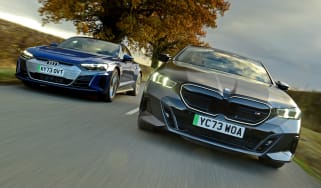Audi e-tron GT review
Spectacular looks and performance, plus contemporary EV tech, make the Audi e-tron GT one of the most desirable luxury saloons around

The all-electric Audi e-tron GT four-door coupe/saloon is similar to the Porsche Taycan in more than concept, because the pair share a floorpan and 40 per cent of their components. However, Audi’s take on a four-door high-performance EV is a little less hard-core than Porsche’s, trading the latter’s firm suspension and meaty steering for a softer ride and less demanding character. In other words, it rides and drives just as fans of expensive Audis have come to expect.
With a roomy five-seat cabin stacked with the latest technology, and has charging speeds that make long distances a breeze, it would be churlish to suggest the e-tron GT is not worth the money. Thanks to spectacular acceleration, impressive ride and handling, easy-driving manners, and a beautifully appointed cabin, the e-tron GT is a thoroughly desirable high-performance saloon.
About the Audi e-tron GT
If you wanted an all-electric luxury saloon a couple of years ago, the Tesla Model S was the only game in town. It took a few years for the auto industry ‘establishment’ to catch up with Elon Musk’s disruptor company, but products like the Audi e-tron GT and its VW Group stablemate, the Porsche Taycan, reveal a depth of sophistication that some would argue only a dyed-in-the-wool auto-maker can muster.
Used - available now

2024 Audi
E-Tron GT
16,238 milesAutomaticElectric
Cash £38,317
2024 Audi
E-Tron GT
42,202 milesAutomaticElectric
Cash £37,396
2024 Audi
E-Tron GT
17,979 milesAutomaticElectric
Cash £40,103
2024 Audi
E-Tron GT
18,147 milesAutomaticElectric
Cash £39,358It’s also interesting to note the speed of the VW Group’s response to the new EV world order that Tesla has helped to usher in. The e-Tron GT was the first Audi to be put into production without the use of any physical prototypes, and the first cars left the factory just two years after the concept was revealed in 2018 in Los Angeles. In-between times, the car also appeared in the 2019 Marvel movie Avengers: Endgame, with Tony Stark (Iron Man) at the wheel.
In terms of the finished result, this stunning Audi EV gives away little to its closest relative, the Taycan, in terms of style, performance, luxury, or, indeed, price. The brand is so confident in the e-tron GT that its price starts above the base Taycan – although you do get a larger 93kWh battery pack (versus the 79kWh pack of the Porsche) thrown in. There’s also a performance version called the RS e-tron GT, which is only a few grand short of the price of the hottest Taycan Turbo S.
While the Model S has fallen out of contention given that it is no longer available in anything less than exceptionally fast Plaid trim and is left-hand drive only in the UK, the Audi e-tron GT does have other competition in the form of the luxurious BMW i5 and long-range Mercedes EQE, while the Genesis Electrified G80 would be a cheaper left-field choice. All are big luxurious five-seat saloon cars, and have versions with phenomenal performance and impressive range derived from a large capacity battery pack.
The Audi is built on the J1 platform developed jointly by Audi and Porsche, and although it’s not the firm’s first EV, it’s the first to be built in Germany. Audi’s R8 factory in Neckarsulm was given the honour of producing the e-tron GT, and unusually, these two entirely different models are built on the same production line.
The e-tron GT features a motor on both front and rear axles, giving every version four-wheel drive, and helping to deliver up to 523bhp (more on that later) in ‘basic’ e-tron GT quattro spec, and 590bhp in the go-even-faster RS e-tron model – or 637bhp for a few seconds when you activate boost mode.
Acceleration off the line is eye-wateringly quick, with a 0-62mph sprint of just 3.3 seconds claimed for the RS model. The maximum quoted range is 298 miles on a full charge, and while that’s beaten by the i5 M60 and the hottest AMG 54 EQE, the Audi’s rapid charging capacity means you can theoretically put a 60-mile top-up into the 93kWh (83.7kWh useable) battery in just five minutes. That’s assuming you have access to 270kW charging, of course.
There are just two trim levels in the standard e-tron line-up: the regular e-tron GT and the more luxuriously appointed Vorsprung trim. The latter includes such luxuries as 18-way adjustable massaging seats, Matrix LED laser headlamps, a head-up display and semi-autonomous tech, as well as adaptive air suspension and four-wheel steering. The RS e-tron GT comes in standard, Carbon Black, or Carbon Vorsprung trims. Air suspension is standard across the RS line-up.
Electric motor, drive and performance
Like most new things in the automotive world, EV tech is largely filtering down from the top. That means it’s typically the most expensive option in whichever class you’re shopping, and in the luxury saloon segment, impressive driving characteristics are a prerequisite to match – or beat – existing flagship models. The 563bhp Audi S8 saloon is a case in point, and the e-tron GT steps up to the mark with a ride and handling set-up that is truly impressive – especially when equipped with adaptive air-suspension, which can be added with the Technology Pack Pro or fitted as standard on e-tron GT Vorsprung models.
There are four selectable drive modes, with comfort best suited for UK roads. It’s soft enough to deal with rougher road surfaces while maintaining excellent body control, which means body lean in corners is almost non-existent, an area where the floaty Mercedes EQE suffers. The e-tron GT provides such a good compromise in comfort mode, that you’ll rarely even have to contemplate switching to the sportier Dynamic mode.
The latter drive mode does have some other advantages, such as shifting the torque bias towards the rear wheels, which allows for rear-wheel drive style drifts on the track if you’re so minded, while the ride and steering firm up a little. Efficiency mode has a front-wheel drive bias, with slightly slower motor responses designed to maximise range. The Individual mode allows various driving parameters to be personalised to your taste.
The e-tron GT is a big, heavy car at 2.3 tonnes, but positioning all the battery weight low down in the floor means it’s very well-balanced and – even without adaptive air suspension – isn’t prone to leaning over much in the bends. Like the Taycan, there’s an impressive sense of poise when cornering, although the Audi’s softer suspension settings plus its lighter steering means the Taycan feels considerably more agile.
Still, there’s a directness and precision to the e-tron GT’s steering that makes it easy to place the front end of the car through corners - a trait somewhat lacking in its BMW i5 rival. The car's weight is effectively masked by the air suspension over all but the most challenging roads, while the four-wheel steering of Vorsprung models reduces the turning circle to that of a family hatch.
Cast iron discs handle braking as standard, although more fade-resistant carbon discs are optional on all RS e-tron GT models. There’s also a regenerative braking function from the twin electric motors, which Audi calculates takes care of 30 percent of retardation in normal driving conditions. It’s useful, but the braking effect is relatively weak, and Audi hasn’t developed the system to the point where you can drive using just the accelerator pedal in stop-start traffic as you can in a Nissan Leaf.
For drivers who remain unmoved by the magic of electric propulsion, a Sound Package is available that creates digital engine noise inside the cabin and exhaust notes for the benefit of passers-by.
Engines, 0-60 acceleration and top speed
Most of the time, the twin-electric motors of the standard e-tron GT combine to put out 469bhp, with the full 523bhp potential being reserved for short 2.5-second bursts when in Dynamic drive mode and with launch control engaged. At full power, the 0-62mph time is a rapid 4.1 seconds, which is a figure you’d need the far pricier BMW i5 M60 or Mercedes EQE AMG 53 in order to beat.
Even without its ‘boost’ mode activated, the e-tron GT provides quick acceleration far exceeding a traditional petrol or diesel car, and it has no trouble getting up to motorway speeds. Our only slight complaint is a somewhat lazy accelerator response, needing a fair amount of travel before the car takes off with haste. It’s something to be aware of when merging quickly into traffic.
In the RS e-tron GT, the rear motor’s output is increased to 590bhp or 637bhp in boost mode, hence the 3.3 second 0-62mph time. On the appropriate road, the RS e-tron GT can hit 155mph flat-out, while the standard e-tron GT quattro is not far behind at 152mph.
As you’d expect from an EV, there’s no requirement for changing gear. However, unlike most EVs, the rear motor on the e-tron GT, like its Porsche Taycan sibling, has an automatically-selecting two-speed transmission with a low ratio for maximum acceleration.
Range, charging and running costs
No car costing more than £87,000 is going to be a cheap date for a private buyer, electric or otherwise. However, anyone who can run the e-tron GT as a company car is on to an absolute winner thanks to HMRC's efforts to incentivise the uptake of electric vehicles.
The Benefit-in-Kind (BiK) tax rates for the e-tron GT are far lower than they would be for a regular petrol, diesel, hybrid, or plug-in hybrid. This means even a higher-rate tax payer will save thousands running an e-tron GT compared with the equivalent Audi S8.
There’s another financial incentive for road tax or Vehicle Excise Duty, because zero tailpipe emission vehicles are currently exempt from the luxury car premium until 1 April 2025. Beyond this date, they’ll be subject to annual charges, and you can read more about this on our dedicated car tax page.
London-based drivers and those who commute to the capital benefit from being excluded from the Congestion Charge zone, although this will change from 2025 onwards. Other cities around the UK have introduced their own Ultra Low Emissions Zones, so e-tron GT drivers will benefit from reduced costs when driving around these areas, too.
It’s not all a free ride, because you can expect hefty service and maintenance costs from your Audi main dealer, while the combination of vehicle weight and performance means there’s the potential for frequent tyre replacements. You can claw some money back in reduced brake pad and brake disc wear by utilising regenerative braking more often to slow down, though.
Electric range, battery life and charge time
Both versions of the e-tron GT share the same 93kWh (83.7kWh useable) battery, but the extra power of the RS model naturally affects the range you can achieve. Audi quotes an official maximum of up to 305 miles for the e-tron GT quattro and 294 miles for the RS e-tron GT. Naturally, you can expect these figures to drop dramatically if you dig into the phenomenal performance regularly.
Compared with the maximum 354.2-mile range of the BMW i5, and the near 380 miles you get from a fully-charged Mercedes EQE, the available range of the e-tron GT might be considered wanting, but the Audi fights back with a faster charging capacity of 270kW compared to 250kW for the i5, and only 170kW for the EQE.
Charging an e-tron GT at peak performance means you can get from 10 to 80 per cent state of charge in just over 20 minutes, provided you’ve found a fast enough charger. Most owners will probably look into the convenience of home charging, and using a standard 7kW wall box installation should take around 14 hours to fully recharge a flat battery.
Insurance groups
Insurance costs are not an area where e-tron GT drivers will be able to make savings, as the combination of extreme performance and expensive repair costs means premiums for all models are in the top bracket at Group 50. If you need something cheaper, you should look at a BMW i5, which starts in group 43.
Check your tax status and renewal date in seconds. Check your VED car tax now...
Depreciation
German high-performance saloons have typically looked extremely good value on the used market thanks to crippling depreciation numbers. Unfortunately, the e-tron GT continues this trend, because our experts predict that after three years and 36,000 miles, it’ll retain between 37-44 per cent of its original value, with the pricey Vorsprung trim being the worst performer.
We’d suggest looking at the BMW i5 instead if you need something that depreciates less, because that is predicted to be worth between 49-52 per cent over the same time period.
To get an accurate valuation on a specific model check out our free car valuation tool...
Interior, design and technology
Few would argue with us when we say that the e-tron GT is a bit of a stunner and, in spite of the car’s size, it has swoopy lines and powerful proportions of the kind more often seen on out-and-out sports machines.
The low-slung look is not a clever design trick, but a neat feature enabled by an underfloor battery pack with built-in footwells for rear passengers. This gives passengers in the rear a place to put their feet, and means the seats can be set lower, allowing for its low-profile coupe-style roofline without harming practicality.
As you’d expect, the e-tron GT’s profile is similar to the Porsche Taycan’s, but the two cars have distinctly different front and rear ends. The e-tron GT has a distinctive flat and wide bonnet and muscular haunches, while closer inspection reveals details such as the active air vents in the grille that close for streamlining and the wide rear diffuser and extendable rear spoiler, which suggest form is following function. Indeed, the active aero features help reduce the drag coefficient to just 0.24, the lowest of any current Audi.
Inside the cabin, the ambience is less futuristic than one might have expected from a flagship electric saloon from Audi. Although the Virtual Cockpit instrument display and central touchscreen are state-of-the-art, you don’t quite get the wall-wall tech feel that the extended double screens of some contemporaries provide, such as the latest BMW i5
The interior design is relatively restrained, and even somewhat traditional, although Audi makes much of its use of environmentally-sourced trim materials such as a vegan ‘leather’ and recycled wood finishes. You can’t fault the fit and finish either, which is up to the standards you would expect of a top-level Audi.
Sat-nav, stereo and infotainment
The e-tron GT gets Audi’s MMI Touch navigation system running on a 10.1-inch colour display in the centre of the dashboard, which is linked to the 12.3-inch Virtual Cockpit screen that replaces a traditional instrument pack in the binnacle ahead of the driver. You also get the Audi Wireless Smartphone Interface with Apple CarPlay and Android Auto connectivity and wireless charging.
Selecting the Technology Pack, Technology Pack Pro, or upgrading to Vorsprung trim level adds Bang & Olufsen 3D premium sound system with 16 speakers and a 710-watt output. The B&O sound system is standard on all RS trims.
You’ll need to add the Tour pack to the standard e-tron GT to get adaptive cruise control (standard on Vorsprung), while the Technology Pack Pro gives you a head-up display.
Practicality, comfort and boot space
In spite of its low-profile sporty looks, the e-tron GT is a comfortable and spacious cruiser. The interior layout is focused around the driver, who is separated from the passenger by a wide central console, while the central touchscreen is angled toward the driver, too.
A pair of large drink holders are between the seats, and the wireless phone charging pad lives in a recess on the console. The doorbins on either side are a little shallow, and have limited access due to the armrests above, making it difficult to store a large bottle of water. The glovebox is complemented by an additional lidded compartment under the centre armrest for stashing things out of sight. It’ll be fine for some, but the BMW i5 has greater storage.
The high quality of fixtures and fittings add to a generally welcoming ambience throughout the cabin, while the lack of engine noise helps to create a relaxed travelling environment for all onboard.
Twin charging flaps – one on each side behind the front wheels – make access easy. Two charging cables are supplied as standard; a Type 2 cable for public AC chargers, and a three-pin plug adaptor for home charging without a dedicated wallbox.
Dimensions and size
The e-tron GT isn’t unusually big for a luxury executive model, but it is unusually low. Its 4,990mm length and 1,960mm width compares closely to the 4,946mm long and 1,961mm wide Mercedes EQE. The e-tron GT is just 1,410mm tall against the 1,510mm EQE and 1,515mm i5.
Leg room, head room & passenger space
The Audi e-tron GT cabin is very roomy up front in spite of its low-slung appearance. While you might expect to find headroom restricted, especially in the back, the battery pack has been designed with a footwell recess built into it, adding to the available space for rear passengers’ feet under the front seats.
The design requirement for a large battery also necessitated a long wheelbase, which means there’s no shortage of legroom either. There’s loads of shoulder room upfront, but the heavily sculpted outer rear seats – which feel like individual armchairs – mean the raised central position isn’t as welcoming for three adults to sit comfortably in the back compared with the i5.
The rear doors open wide to give good access too, but the car’s low cabin means you need to be relatively supple to spring in and out gracefully, and it could make putting a child in a car seat a bit difficult. The e-tron GT has two ISOFIX child seat mounting points on the outer rear seat positions.
A panoramic sunroof gives the e-tron GT a light and airy feel in a cabin that might otherwise feel a little claustrophobic. With that in mind, we’d suggest you think carefully about the carbon roof option on an RS model.
Boot space
The e-tron GT doesn’t have a huge boot, although it’s respectable at 405 litres, especially next to the 430 litres provided by the EQE and 490 litres in the i5. The e-tron GT does at least have a further 85 litres available under the bonnet, where owners can conveniently keep grimy charging cables well away from their clean luggage.
The car’s practicality is compromised a little by the shape of the narrow boot opening, but if you want a luxurious electric load-lugger, Audi will happily direct you to its Q8 e-tron SUV.
Reliability and safety
To date, the Audi e-tron GT hasn’t been crash tested by safety experts Euro NCAP, and while its closely related sibling, the Porsche Taycan, has been (and received the maximum five-star rating in 2019), that result hasn’t been validated for the e-tron GT.
Unless you opt for the pricier Vorsprung trims, some of the advanced safety systems are optional. You’ll need the Tour pack for adaptive cruise control and traffic sign recognition, while the City Assist Pack includes lane change assistance and cross-traffic warnings.
The Audi brand has slipped down the Driver Power rankings, coming in a woeful 30th place out of 32 manufacturers in the 2023 survey. That puts it behind Mercedes, BMW, Jaguar, and even upstart Tesla.
The overall build quality, and the integrity of the e-tron GT’s fundamental engineering is highly impressive, though. The car can receive over-the-air updates, so new software can be sent remotely, minimising the need to visit the dealer.
Warranty
Like all cars in the Audi line-up, the e-tron GT is covered by a three-year or 60,000-mile warranty. That’s fairly standard in the luxury car sector, lagging behind the three-year/unlimited mileage policies of BMW and Mercedes, or the five years of cover provided by Genesis.
Audi also issues an eight-year or 100,000-mile warranty that guarantees battery performance above 70 per cent capacity during that period – hopefully eliminating a major cause for concern amongst some potential electric car customers. It’s worth adding that Genesis has a longer 120,000-mile guarantee, while Mercedes goes even further by guaranteeing the battery for 10 years and up to 155,000 miles.
Servicing
With fewer moving parts the basic service regime required for an EV is less rigorous than for traditional cars, and this is reflected in a trio of service packages that can be bought in advance for all the Audi e-tron models, including the e-tron GT, and can be paid for up front, or over a number of monthly payments.
Level 1 covers a single service, Level 2 two services, while Level 3 covers you for two services, and two MoT tests in the third and fourth years of ownership.




















